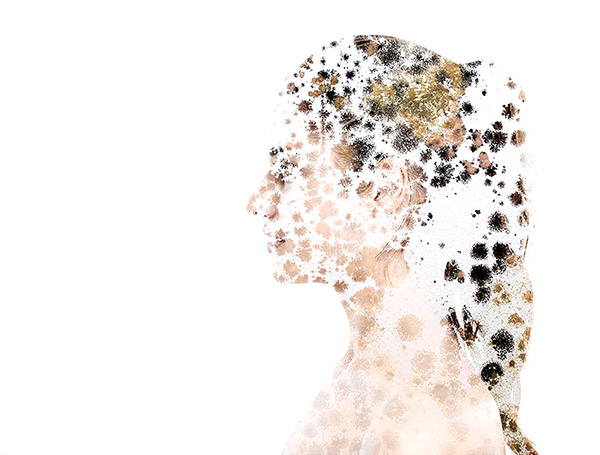William J. Rea, M.D., F.A.C.S., F.A.A.E.M.

Mold and mycotoxin exposures have come to the forefront of illness due to faulty construction, leaks, and other forms of moisture intrusion which allow them to grow indoors. Many houses have been contaminated with molds and mycotoxins thus making the inhabitants ill.
There are certain molds that seem more prominent in causing sensitivity than others. These include the molds designated in mold mixes 1-4 as shown in Table 1, Rhizopus,Trichoderma, Stachybotrys, Monilia Sito, Drechslera, Curvularia species, Cladosporium Herbarium, Cladosporium Fulvum, Streptomyces, and numerous Streptomyces groups.
Aspergillus species occur in many forms. Aspergillus fumigatus seem to be the species which is related to the most health and sensitivity issues. Treatment derived from skin testing of the most common indoor and outdoor molds shown in Table 1 has proven to provide initial relief to those suffering from mold sensitivity. This mold antigen therapy has become known as the first line of defense and seems to provide relief when given every 4 days intradermally.
If the patient does not obtain satisfactory relief from mold sensitivity after three weeks of treatment, then additional species of mold can be skin tested and treated. The additional molds to be skin tested and treated are shown in Table 2. Treatment is very specific for each individual and represents exact strengths and amounts of antigen derived from the skin testing. The neutralizing dose for each mold represents a dose to which the patient, after careful intradermal testing of several dilutions, showed no skin or symptom response. The treatment dose for each item is precise and can be safely self-administered until all symptoms clear – 3 months to 1 year.
Sometimes exposure to specific molds which produce mycotoxins requires that persons receive skin testing and treatment to negate an allergic response to mycotoxins. Treatment is arranged and antigens are taken every 4 days. These mycotoxins for which treatment can be arranged are seen in Table 3.
Discussion:
The majority of patients do well in 3 months but some take 6 months. Treatment response usually depends on the success of the remediation of all molds and mycotoxins from the buildings, furnishings and personal belongings. Another important factor in a successful treatment outcome is the response of the immune system to the antigen injections.
The treatment of mycotoxins is also important to combat any sensitivity reactions to the mycotoxins which could be present in the body. The antigen therapy would reduce this sensitivity response until proper detoxification procedures could be introduced. The EHC-D is experienced in protecting cellular health, lessening sensitivity response, and in removing the chemical mycotoxins from the body‘s organs and tissue. As the patient gains tolerance and strength through antigen therapy, oxygen therapy and IV nutrient therapy, the patient is prepared for involvement in the deep heat chamber chemical depuration program.
The avoidance of mold exposure in the home environment and in your diet and the injection treatment of molds and mycotoxins should be more cost effective than medication treatment with antifungal drugs, antihistamines, and their complications. The complete treatment approach of immunotherapy and removal of mycotoxins from the body enables the patient to continue the road to recovery of many facets of physical health.
Table 1:
- Mold Mix #1 (Alternaria, Aspergillus, Hormodendrum)
- Mold Mix #2 (Epicoccum, Fusarium, Pulluraria)
- Mold Mix #3 (Mucor, Phoma, Fomes, Rhodotorula)
- Mold Mix #4 (Cephalosporium, Helminthosporium, Stemphylium, Geotrichum)
Table 2:
Sporobolomyces
Trichoderma
Stachybotrys
Monilia Soto
Drechslera
Clad. Herbarium
Clad. Fulvum
Streptomyces
Penicilum
Aspergillus Mix
Table 3:
Mycotoxins
Aflatoxin
Fusaric Acid
Trichothecene
Gliotoxin
Ochratoxin
Signs and Symptoms
- Excess fatigue
- Excess aches and pain
- Headache
- Short-term memory loss
- Loss of balance
- Dizziness
- Ears ringing or popping
- Sneezing
- Coughing
- Wheezing
- Shortness of breath
- Skipped heart beat
- Cold hands or feet
- Spontaneous bruising
- Little red spots
- Acne-like lesions
- Swelling
- Intestinal upset, gas, bloating
- Numbness and tingling of hands and feet
- Hair loss
- Epistaxis (blood in nose)
- Dermatitis, rash
- Eczema
We have successfully treated at least 5,000 patients who suffered from mold and mycotoxin exposure.
